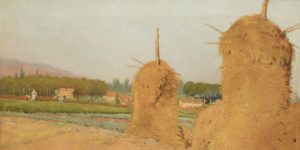0 results
Biografia
Born in Barcelona in 1871, Anglada-Camarasa studied painting against the will of the family. He trained first with the artists Tomàs Moragas and Modest Urgell, and later at the School of Fine Arts, La Lonja, in Barcelona, before continuing his training in Paris, where he settled in 1894. There he attended classes at the Academy Julian, where the painters of the Nabis group were trained. At first he was a painter of realistic landscapes -the Sala Parés in Barcelona hosted his first individual exhibition, in 1894, with this genre of painting-, but after his stay in the French capital, his work evolved towards the representation of Parisian nightlife, with a marked colorism and mundane female figures. This stage of his career gave him a certain fame, and allowed him to reach international audiences by exhibiting all over the world.
Following a summer stay in Valencia in 1904, he became interested in Valencian folklore and changed the theme of his works. He dedicated himself then to the representation of gypsy figures and women in regional Spanish costumes —suits, shawls, shawls and jewelry— with a high level of detail, which led to the development of a certain decorativeism in his painting.
Influenced by a painter friend who lived on the island, he traveled to Mallorca in 1909 for the first time, on Gaudí's recommendation, and settled there five years later, at the start of the First World War. The landscapes of Mallorca became the central theme of his work, leaving aside the themes developed in Paris. He recovered the genre of his first paintings, the landscape, but he focused on representations of scenes from his new environment —countryside and coastal environments, fish and the seabed— and in a radically different way: he abandoned realism in favor of more dreamlike views, inspired by both the Impressionists and Post-Impressionists as well as the Fauves, in which the exaltation of color and light dominates. During this period, faced with the development of the avant-garde in Europe after the Great War, Anglada-Camarasa redirected his career towards the United States. From 1924 to 1934 he participated in numerous collective exhibitions in different North American cities: Pittsburgh, Washington, New York, Chicago, Los Angeles, Dallas, Cleveland, among others. The painter's first period in Mallorca lasted twenty-two years, until 1936.
When the Civil War broke out, Anglada-Camarasa was in Barcelona. Due to the political situation, he was unable to return to Mallorca, which soon fell into the hands of Franco's army. At that time he found refuge in the abbey of Montserrat, where communities of monks had settled since the 10th century. The rugged landscapes of Montserrat, which presents a unique orography, were a great source of creativity for Anglada-Camarasa during his stay there. His representations of Montserrat are the most characteristic ones from this period.
At the outbreak of World War II, he went into exile with his family in France, in Pougues-les-Eaux (Burgundy), until he returned to Mallorca in 1947. In the French stage, representations of vases, still lifes and landscapes abound, along with some human figures. Already in Mallorca, his work became increasingly scarce, due to an accident he suffered in 1953. He died in 1959 on the island where he had spent a good part of his life and which has deeply inspired his work.

